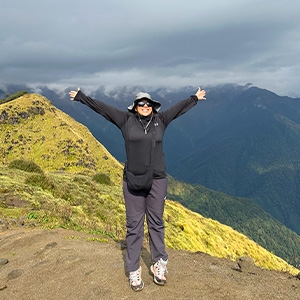There is no disputing the fact that Nepal is the world's most mountainous nation, with 8 of the 14 majestic Himalayas over 8,000 meters in height and as many as 1300 peaks, making it the ideal location for peak climbing. Peak climbers, trekkers, and tourists from all over the world enjoy an abundance of adventurous experiences in Nepal. Peak climbing is undoubtedly the most dangerous sport in Nepal. It is indisputable that no other country has as many mountains as Nepal.
For peak climbers, trekkers, and tourists from across the world, Nepal is home to 8 of the 14 beautiful Himalayas over 8,000 meters in height, providing a wealth of thrilling experiences. Everest (8,848 meters), Kanchenjunga (8,586 meters), Lhotse (8,516 meters), Makalu (8,463 meters), Cho Oyu (8,201 meters), Dhaulagiri (8,167 meters), Manaslu (8,163 meters), and Mount Annapurna (8,091 meters) are the world's tallest peaks. In addition to the world's highest summits, Nepal is home to more than 1,300 peaks over 6,000 meters, with approximately 400 of them open for climbing, including the highest peak in the world, Mt. Everest (8,848 m). a source of interest and motivation for people who pursue extreme adventure through peak climbing.
The number of people traveling to Nepal for peak climbing has increased as a result of their achievement in reaching the summit of Mt. Everest, which is the highest peak in the world. The peak-climbing sport is popular not only because it is daring but also because it provides a perfect view of the stunning mountains and other incredible landscapes. Along the trail, you will also be able to visit the charming villages of different ethnic and caste groups, learn about their unique cultures, rituals, and ways of life, try their local food, and walk through a jungle full of different plants and animals. It is very important to pick a peak that is right for your level of experience and fitness. When planning a trip to Nepal to climb a peak, it is important to think about the time of year and the weather. In Nepal, spring and fall are often the best seasons for peak climbing. The temperatures are moderate at this time, and the weather is among the most consistent. You will need to make an investment in the proper equipment and safety measures if you plan to climb a peak in Nepal. Additionally, make sure the guide you choose is knowledgeable about the area and the terrain. This will make the journey safer and much more successful. These are a few examples of the reasons why peak climbing in Nepal is unique and satisfying. Footprint Adventure offers climbing trips to Nepal's most popular peaks, like the top six peaks listed below:
Mera Peak Expedition (6,476 m)
- Days: 18 days
- Trip Grade: Strenuous
- Trip Style: Trekking/Climbing
- Maximum Altitude: 6,476 m
- Trekking Region: Everest Region
- Accommodation: teahouses, lodges, and camps
- Best Season: March-May, September-November
Mera Peak is a popular peak in Nepal that is frequently visited by trekkers. It is the highest trekking peak in Nepal, reaching 6,476 meters, and is located in the Mt. Everest region of Nepal. Climbers of all levels of skill go to Mera Peak, making it a desirable destination for mountaineers. Even though the path to Mera Peak is not overly complicated, it does take a decent level of physical ability to complete it.
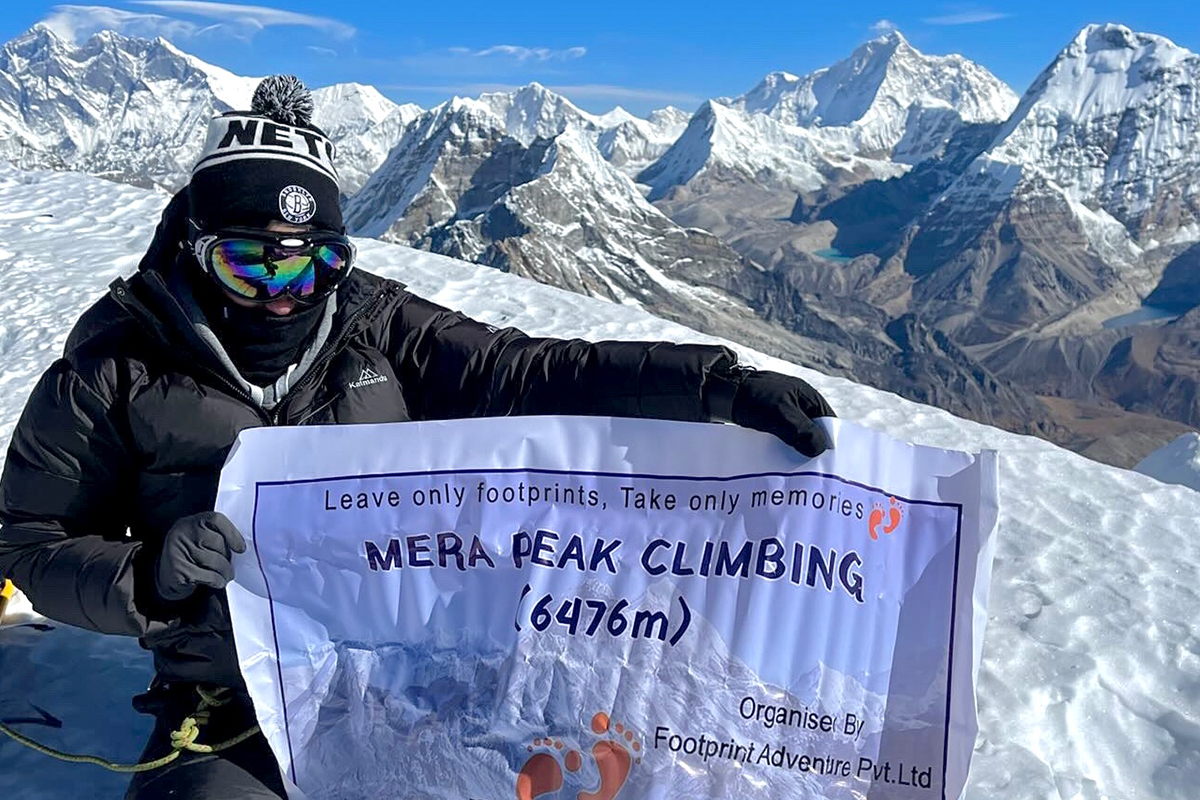
Mera Peak's route passes via the well-known Khumbu region. And this area has everything: unique Sherpa villages, green forests, swinging suspension bridges, traditional gompas, monasteries, prayer flags, and more. There is a concern about altitude sickness wherever there are mountains. This mountain sickness may occur at higher elevations than 3500 meters. You can travel to Mera Peak from Kathmandu at 1400 meters, to its highest peak at 6,476 meters (Mera Peak). Between these two locations, you will experience daily altitude changes. Because of this, anyone who is not used to living at high altitudes or in a new place is more likely to get acute mountain sickness (AMS) or altitude sickness. And this is among the trickiest parts of climbing Mera Peak. Both experienced climbers and beginners can participate in this 18-day expedition. Training is very important before a climb, and you will get training from a trained climbing guide while on the expedition. You will encounter certain challenges because climbing requires the use of various tools. So, in order to climb, you must first prepare physically and emotionally. A wonderful technique to improve endurance and stamina is aerobic and cardiac exercise.
This adventure combines mountain climbing with trekking in Nepal. Since it is a trekking peak, climbing it requires NMA authorization. If you're a new climber looking to scale your first Himalayan mountain, Mera Peak is for you. Another significant feature of this expedition is Mera High Camp (6100 m). The camp is situated right at the foot of what appears to be a mountain that has been partially scraped off. You experience alpine-style camping at both Mera Base and High Camp. The view of the neighboring mountain becomes better and better and is endlessly beautiful after you begin your climb from the high camp. Mera Peak's summit has the best and most breathtaking views of the Himalayas because of where it is in the area. The entire climb is difficult physically and mentally, just like any other mountaineering journey. But once you reach the top, it is totally worthwhile.
Highlights of Mera Peak
- Lukla Airport is a short, scenic, and thrilling flight to the world's most dangerous airport.
- A delightful and incredible off-the-beaten-path walk across the Mera Peak valley.
- Discover the diverse ethnic communities of the Sherpa people.
- Numbur and Nupla mountains from Lukla Airport.
- Explore the breathtaking vistas of mountains and glaciers while acclimatizing to the historic village of Tangnang.
- The highest trekking peak to climb is in Nepal and in the Everest region.
- Find out about the rich variety of plants and animals and what emerald forests, Buddhist shrines, and small villages look like at night.
- The tallest mountains in the world, including Everest, Lhotse, Makalu, Cho Oyu, and Kanchenjunga, can be seen from here.
Chulu West (6,419 m)
- Days: 18 days
- Trip Grade: Strenuous
- Trip Style: Trekking/Climbing
- Maximum Altitude: 6,419 m
- Trekking Region: Annapurna Region
- Accommodation: Teahouses/ Camps
- Best Seasons: March-May, September- November
Chulu West Mountain is yet another 6,000-meter+ climbing peak in the midwestern region of Nepal. The summit is located in the gorgeous Annapurna region. Climbers set off from Ledar village to Chulu base camp on one of the most breathtaking trekking routes in the entire world to begin their peak-climbing expedition. The mountain is next to the strong Annapurna Massif range, with Himlung Himal to the northeast and the strong Manaslu peak to the west.
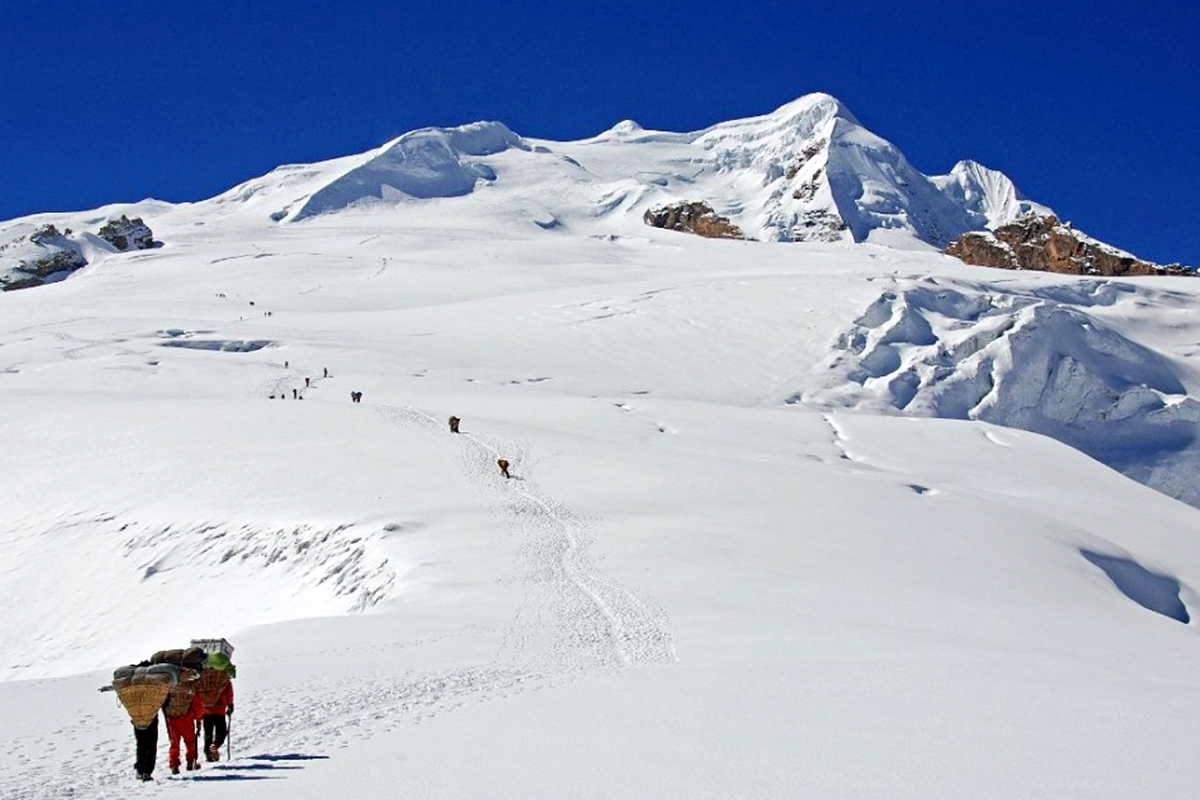
Many times, climbers are unsure whether the climb is on the east or west side of Chulu Peak. To put your misunderstanding to rest, Chulu Peak has four summits, two on the west and two on the east side. Compared to east climbing routes, west climbing routes are thought to be safer and less complex. The peak is rated as PD/3, and we climb it using the Chulu West Peak route. Climbers with beginner and intermediate experience levels can successfully summit this peak. Climbers will mostly rely on their stamina and physical power because there aren't many tricky aspects. All the way up to the summit, the trek is primarily on ice and snowy terrain. Our lead and assistant guides' instructions must be followed exactly as they are given. The two alpine camps that our group will create are high camp and base camp. We will return to base camp after the summit before traveling to Thorong-La Pass. In comparison to the Everest region, the Annapurna region is comparatively less crowded with climbers and trekkers.
Therefore, if you're a climber looking for a trail that's less traveled and more remote, this is your best option. Still, the Annapurna area of the Himalayas has kept all of its natural beauty. It delivers a distinct beauty and creates a unique image. The Annapurna Circuit region is everyone's favourite due to its accessibility, culture, scenery, enormous mountains, isolation, and a host of other factors that we could go on and on about.
Highlights of Chulu West
- Beautiful natural features including rivers, waterfalls, dense forests, and hidden landscapes can be explored in the Annapurna region.
- Stunning views of the Majestic mountains including the Annapurna, Dhaulagiri, Ganesh Himal, Lamjung Himal, Manaslu, Machhapuchhre, Nilgiri, and Tilicho peaks are both breath-taking and beautiful.
- Explore the unique cultures of many ethnic groups.
- Pass via one of the highest points, Thorong La (5416m), then travel to Sacred Muktinath Temple.
- Summit to one of the easiest trekking peaks in the Annapurna Region
- Hiking in the picturesque Annapurna region and enjoying 360-degree panoramic views of the Mountains from the summit
- Alpine camping at base camp and high camp
Island Peak Climbing (6,189 m)
- Days: 18 days
- Trip Grade: Strenuous
- Trip Style: Trekking/Climbing
- Maximum Altitude: 6,189 m
- Trekking Region: Everest Region
- Accommodation: Teahouses/ Camps
- Best Seasons: March-May, September- November
The Everest Region of Nepal is home to Island Mountain, which is a popular peak for beginning trekkers. With the aid of crampons and an ice axe, Island Summit (6,189 meters) is a moderately difficult peak that calls for basic mountaineering skills. This journey is ideal for trekkers looking for trekking and peak climbing in Nepal. Imja Tse is the highest point during the Island Peak Climb.
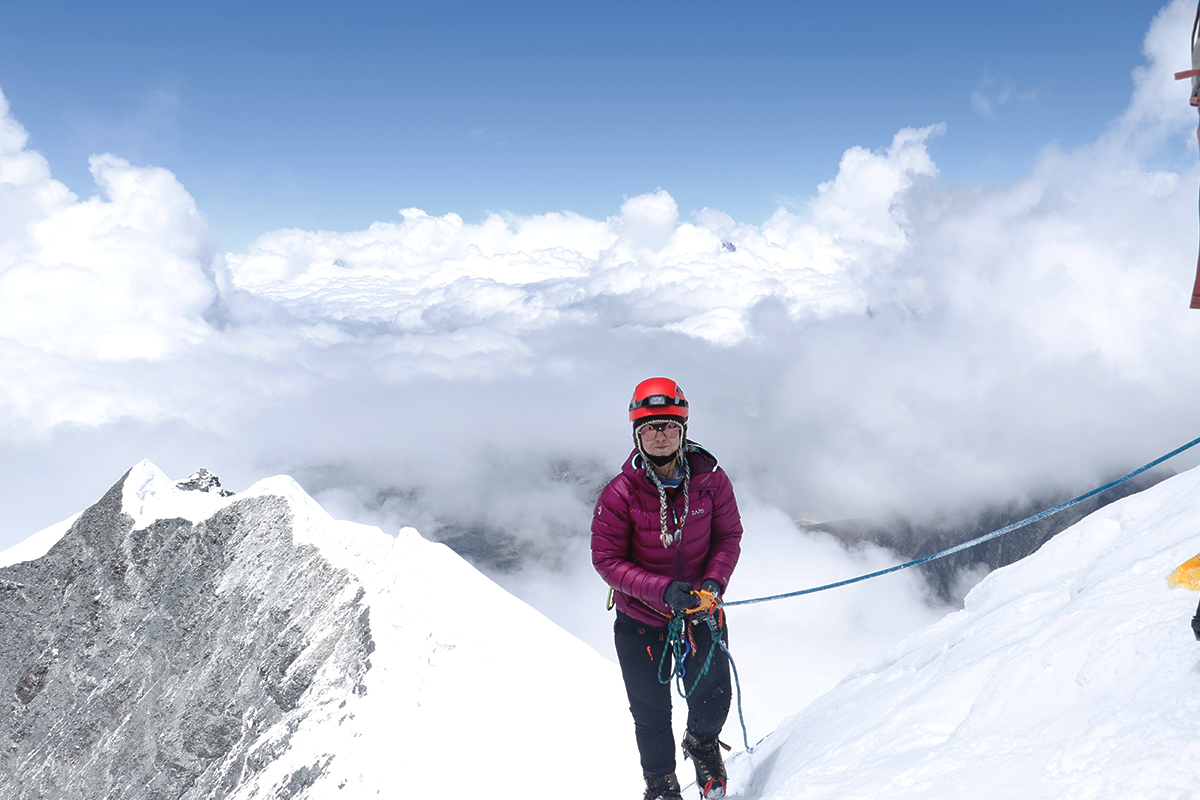
Island Peak climbing is on the same route as Everest base camp, which can be added to the trip itinerary. Despite the fact that this peak is a little lower than Mera Peak, the last push to the summit, a nearly 90-degree vertical climb, is the hardest. Island Summit is a semi-technical climb, which means climbers must use fixed-line ropes to ascend and abseil or rappel down the mountain. The summit day is the hardest because it can be mentally and physically exhausting for people who have never climbed before. Climbers will also need to utilize steel ladders (that will already be in place) to get from base camp to high camp/crampon point because there are extensive crevasses along the way. Because of this, the climb is one of the best for learning the basics of mountaineering and getting a sense of how to fit you need to be to climb bigger mountains. The route to Island Peak consists of heterogeneous terrain, crevasses, glaciers, and sheer ice and rock sides. You will go up through some of the most popular trekking routes in the Everest area, cross a number of passes, and see some of the most beautiful views of the Himalayas. Amazing views of Nuptse, Lhotse, Ama Dablam, Thamserku, and numerous other snow-capped peaks can be seen from Island Peak's summit. There aren't many climbers who can fit at once on the top ridge because of its extreme exposure. Once you reach the top, you will be overcome with a sense of accomplishment, and the views of the Himalayas all around will make it all worthwhile.
Highlights of Island Peak Climbing
- Climbing Island Peak and mountaineering in the incredible Nepal Himalayas
- Sunrise from high on Island Peak
- Beautiful views of Everest, Lhotse, Nuptse, Ama Dablam, Island Peak, and the Khumbu Icefall
- Sunrise over Everest from Namche Bazaar
- Sunset over Everest from Kala Pattar at 5545m
- 3 weeks spent with our Sherpa staff
- The incredible sense of achievement and personal satisfaction that only adventures like this can provide
Lobuche Peak Climbing (6,119 m)
- Days: 18 days
- Trip Grade: Strenuous
- Trip Style: Trekking or Climbing
- Maximum Altitude: 6,119 m
- Trekking Region: Everest Region
- Accommodation: Teahouses/ Camps
- Best Seasons: March-May, September- November
Lobuche Peak represents one of the most renowned and scenic peaks in the Khumbu region of Nepal. It is at an elevation of 6,119 m and has amazing views of Ama Dablam and Mount Everest, which are both nearby. Although the ascent is difficult, the vistas are breathtaking. If you want to experience the magnificence of the Himalayas and test your climbing skills, this is a fantastic trek for you.
Most Everest summit teams use this mountain as one of their training peaks before climbing Everest. Just one day separates Lobuche Base Camp from Everest Base Camp. Lobuche East Peak is rated 2B, similar to Island Peak. Climbers must be comfortable in exposed terrain and must descend using supported fixed-line ropes and abseiling techniques. The majority of the ascent is on rock, ice, and snowy terrain. Unlike Island Peak, the Lobuche summit is narrow and exposed, and Everest is clearly visible from the summit. Depending on the route used and the climber's level of skill, the Lobuche Peak Climb is of varying degrees of difficulty. Climbers with experience can finish the route in one day, with some paths taking as little as six hours from Lobuche Base Camp to the summit. Due to the elevation, the steep hills, and the ice conditions, the climb may take several days for people with less experience. Additionally, because of its unpredictability, the weather can make the climb more challenging. Snow-capped and well-known among climbers, Lobuche Peak attracts a large number of climbers each year. The Lobuche Peak Climbing Expedition is an exciting and daring activity in Nepal that combines trekking and climbing.
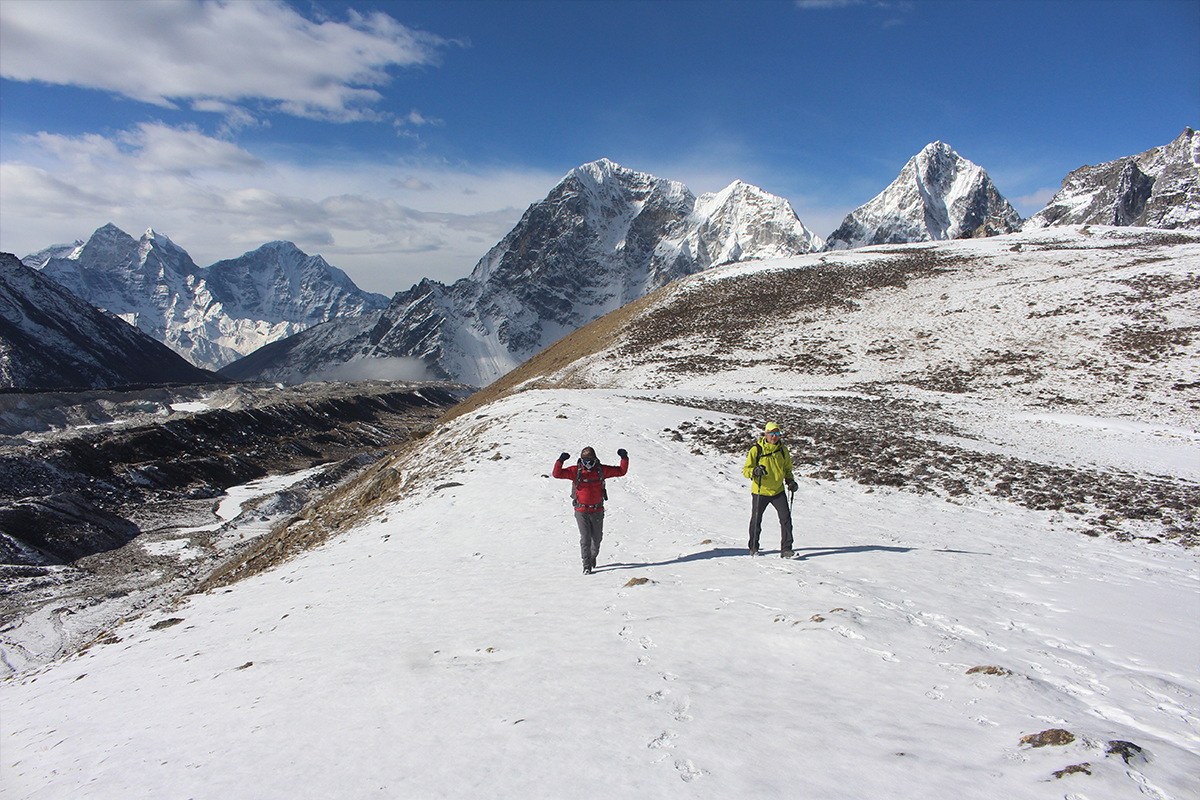
On this tour, you will get the chance to ascend Lobuche Peak and take part in Nepal's most well-known Everest base camp trek. This tour is for people who would rather go on an exciting and adventurous trip than go trekking. The climb, which is between 60 and 70 degrees, might be relatively difficult for climbers at the beginning or intermediate levels. No matter what your climbing objectives are, this can potentially be the ideal mountain to start with.
Highlights of Lobuche Peak
- Climbing Lobuche Peak and mountaineering in the incredible Nepal Himalayas
- Sunrise from the top of the Lobuche peak
- Beautiful views of Everest, Lhotse, Nuptse, Ama Dablam, Island Peak, and the Khumbu Icefall
- Sunrise over Everest from Namche Bazaar
- Sunset over Everest from Kala Pattar viewpoint at 5,545 m
- 3 weeks spent with our incredible guide and climbing crew
- The incredible sense of achievement and personal satisfaction that only adventures like this can provide
- Get a chance to explore the culture of the Khumbu region, Buddhism, and monasteries.
Pisang Peak (6,019 m)
- Days: 18 days
- Trip Grade: Strenuous
- Trip Style: Trekking/Climbing
- Maximum Altitude: 6,019 m
- Trekking Region: Annapurna Region
- Accommodation: Teahouses/ Camps
- Best Season: March-May, September- November
Pisang Peak is located in the Annapurna region of Nepal and is regarded as the second-most popular trekking location in the country. Pisang Mountain is a renowned climbing peak in Nepal as well. The name Jong Ri is also used to refer to this peak's 6,091 meters in height. Pisang Peak's summit is structured like a pyramid and towers majestically above the settlement of Pisang Village.
Trekking and climbing are both enjoyable activities on this 18-day trip. It satisfies the desire to climb the peak and then go trekking in the high Himalayas of Nepal. Pisang Peak, a non-expedition peak that provides a fantastic opportunity for exploration and climbing in the Himalayas, is located between the ranges of Annapurna and Manaslu. Since a German team was the first to reach the top of this peak in 1955, it has become more popular since then. You can witness Dhaulagiri, Manaslu, Annapurna, Annapurna II, Annapurna IV, Gangapurna, and other snow-capped mountains from the summit of Pisang Peak. Although Pisang Peak is rated as a 1B climb, the summit route includes some tough climbing features. When climbing, fixed-line ropes must be utilized. Climbers will have to make their way across icy, snowy, and rocky terrain. Climbers must be physically fit to climb any peaks in Nepal. You will also have the opportunity to march toward the Thorong La Pass. After trekking the Annapurna Circuit route halfway up to Pisang and then taking a different path to the Pisang peak base camp, one can reach this magnificent summit. Both experienced hikers and novice climbers can scale this stunning pyramidal summit. The climbers' ascent of Pisang Peak via the Marshyangdi River valley mainly serves to acclimate them to the summit experience. After climbing the peak, the path goes to the Manang valley and over the 5,416-meter-high Thorong La pass before going back to Jomsom. It is not an easy effort to make a 6000 m trip, and you will encounter many challenges. The obstacles vary widely from person to person and can be severe or relaxing.
Altitude sickness, climbing difficulty, climate and temperature, accommodations, and other issues are some of the major challenges encountered when climbing Pisang Peak. However, you don't need to worry about these challenges. Although they are difficult, with careful planning and preparation, you can conquer them. To finish this climb, you must possess the strong dedication and enough energy.
Highlights of Pisang Peak
- Climb the 6,000-meter expedition peak.
- Discover more about two stunning, uninhabited valleys: Manang and Mustang
- Incredible panorama of many mountain peaks, including Annapurna and Manaslu, among others.
- Explore the trails of the Annapurna Circuit on foot.
- Thorong La is one of the highest mountain passes in the world, and you'll have to travel through it.
- Pay a visit to the sacred Muktinath Temple.
- Discover the breathtaking countryside surrounding Annapurna.
Yala Peak Climbing (5,500 m)
- Days: 14 days
- Trip Grade: Strenuous
- Trip Style: Trekking or Climbing
- Maximum Altitude: 5,500 m
- Trekking Region: Langtang Region
- Accommodation: Teahouses/ Camps
- Best Seasons: March-May, September- November
Yala Peak located in the Langtang region of Nepal is comparatively easier to climb than other climbing peaks and can be accomplished within 14 days. The Langtang region is the third-most-popular trekking region in Nepal. Yala Peak, which is 5,520 meters above sea level, is a great choice for climbers who desire to reach the peak for the first time. Yala Peak is the trekking peak that is the closest to Kathmandu that you can climb.
Yala Peak might serve as a suitable training climb for future high-altitude climbing expeditions. The journey is interesting because of the view of the mountains separating Tibet's northeastern province from Nepal. You may also see the Shishapangma (8,013 m) mountain on the Tibet side in addition to the mountains of Nepal. One of the easiest mountains to climb in Nepal is Yala Peak. Yala Peak may be reached by any fit person. The majority of the summit ascent involves scrambling across difficult terrain. The route from Kyanjin Gompa to Tsergo Ri climbs sharply. The track forks off to the left from this point and ascends to Base Camp, where we set our tent. The trek starts early the following morning as the trail starts its climb through the difficult and rocky terrain toward the top of Yala, our ultimate goal. The trail ascends easy-angled snow slopes from base camp. Crampons, an ice axe, and a man rope are required for the final 700 meters of dangerous ice. After confirming the climbing gear and taking in the sights and sounds of the old Kathmandu valley, we start our journey to climb Yala Peak with a half-day drive from Kathmandu to Syabrubesi. You will reach the magnificent base camp of Yala Peak after walking through a lush green forest and the lovely small villages of Domen, Bamboo, Lama Hotel, Langtang Village, and Kyangjin Gompa. You will also see the effects of the earthquake that hit Nepal in April 2015, especially in the village of Langtang, which was completely destroyed. On the Tibetan side, there are many beautiful mountains, such as Langtang Lirung (7246 m), Lenpo Gang (7083 m), Dorje Lakpa (6990 m), Gangchenpo (6388 m), and the impressive Shishapangma (8027 m).
The Yala Peak Expedition is best during the spring (March to May) and autumn (September to late November) seasons. These are the peak tourist seasons, therefore there could be some traffic on the routes. Climbing Yala Peak in the winter (December–February) may attract some because it is less crowded and the weather is cooler and clearer at that time of year. Winter is also a terrific time to climb if you are well-prepared for the cold. Therefore, this two-week trip to Nepal with the Footprint Adventure team to climb one of the shorter trekking peaks is one of the best options to get climbing experience in the Himalayan region efficiently.
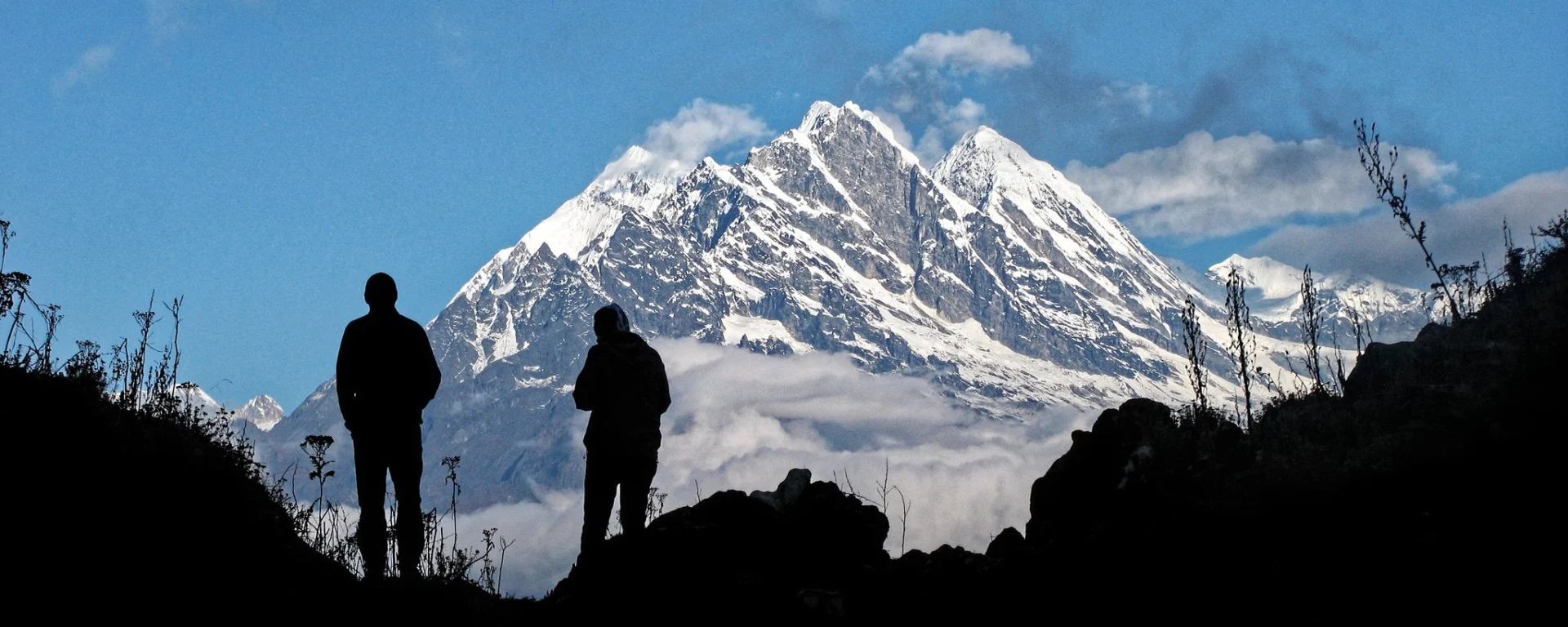
Highlights of Yala Peak
- Beginner-friendly summit for mountaineers
- an incredible journey across the Langtang valley
- Trek with our knowledgeable local Sherpa guides
- Explore Tibetan traditions and culture
- Awesome Yala Peak peak-climbing experience
- Scenic and adventure drive to Syabrubesi, Rasuwa
- Trekking in the Langtang valley means trekking in the valley of glaciers
- Experience the local Tamang & Sherpa people and their culture, practices, and traditions
- amazing views of valleys, alpine forests, glaciers, and rivers
- Many rare animals live there, including the Red Panda, Snow Leopard, Himalayan Monal, and Black Bear
- Explore the ancient Kyanjin Gompa village, monasteries, stupas, and correspondence of Buddhism
- Panoramic views of mountains, valleys, and glaciers from the popular viewpoint of Tserko Ri
These are some of the popular and densely climbed mountains that offer a thrilling experience to both professional climbers, as well as beginners. You can also boost your chances of having a good climb by planning a personalized excursion in advance. For more information about the well-known climbing mountains in Nepal,
contact us.







